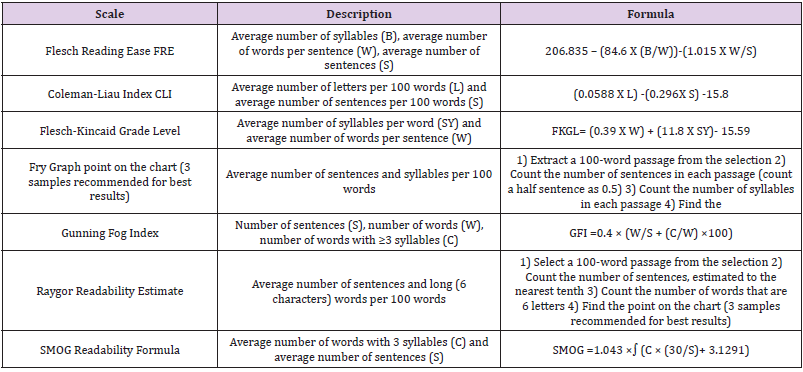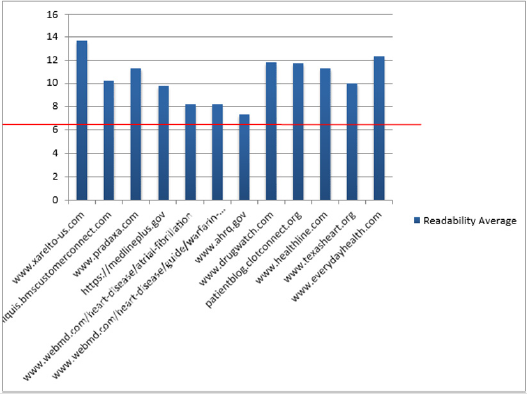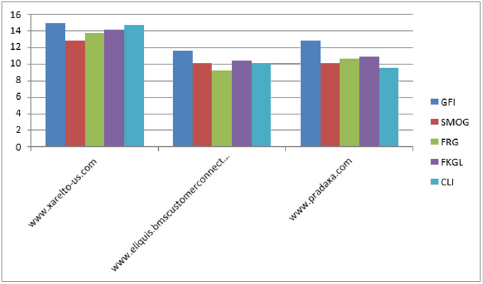Readability Assessment of Internet-Based Patient Education Materials on Anticoagulation Therapy
Introduction
Anticoagulants (blood thinners) are the mainstay
therapy for acute and long-term treatment and prevention of
numerous inheritable and acquired thrombo-embolic disorders
(antiphospholipid antibodies, Protein C deficiency, Chronic atrial
fibrillation, Deep venous thrombosis, Stroke, etc.). A study done
in 2007 by Agency for Healthcare Research and Quality (AHRQ)
revealed that about 4.2 million Americans aged 18years or older had
at least one outpatient anticoagulant purchase. The study further
revealed that there were 27.9 million anticoagulant purchases and
$905.2 million was spent for outpatient anticoagulants in 2007 [4].
Internet based patient education materials (PEM) are playing an
increasingly prominent role in a patient’s understanding of disease
and the patient-physician relationship. Since the advent of the
Web, the practice of medicine has shifted significantly. No longer
is the physician sole gatekeeper of medical knowledge. Patients
have more and more recent medical information at their fingertips.
Internet proposes an easy-to-use, universal access to information
and provides various possibilities to find the latest up-to-date,
barrier free information that is independent of location and time.
Interactive services like online self-help-groups, chats with experts
and forums on special health topics can support active coping and
social support in a virtual community by anonymous contact. 71.7
percent of households reported accessing the Internet in 2011, up
from 18.0 percent in 1997 (the first year the Census Bureau asked
about Internet use) and 54.7 percent in 2003 [5].
The term “health literacy,” as described by the Joint Commission
(formerly the Joint Commission on Accreditation of Health Care
Organizations), refers to “the degree to which individuals have
the capacity to obtain, process, and understand basic health
information and services needed to make appropriate health
decisions.”2 The impact of literacy on health is significant. Adults
with low literacy skills have a poorer health status, 18 have average
health costs that are 6 times higher, 19 are less likely to comply
with medication regimens, and are less likely to understand their
illnesses. Reading level is an important component of health
literacy. The most recent large-scale national assessment of the
average reading level among Americans was performed by the
National Center for Education Statistics in 2003. It found that the
typical American reads between a 7th and 8th grade level [5,6]. The
United States Department of Health and Human Services (USDHHS)
resolved that material is considered “easy to read” only if written
below a 6th-grade level. Material between the 7th and 9th grade levels
is viewed as “average difficulty,” and material above the 9th-grade
level is regarded as “difficult [7]. Readability is a measure of the
grade level necessary for an individual to adequately comprehend a
written document [8]. A number of objective scales have been used
throughout literature to calculate the readability of documents;
including the Flesch Reading Ease Score (FRES), Flesch-Kincaid
Grade Level (FKGL), Simple Measure of Gobbledygook (SMOG),
Gunning Frequency of Gobbledygook (Gunning FOG), Raygor Graph
Grade Level, Coleman Liau Index, Automated Readability Index, and
the Linsear Write Formula.
Materials and Methods
In July 2016, the key phrase, “blood thinners,” was typed into
the Google search engine, and all of the websites that appeared
on the first page of results were opened. In all, there were 12
websites, each one having multiple articles/subsections, for a total
of 69 different hyperlinks related to anticoagulant therapy. The
69 WebPages were then subjected to analysis. The 12 websites
analyzed were as follows (in the order they appeared in the
Google search): Xarelto.com, Eliquis customer website, Pradaxa.
com, medlineplus.gov, WebMD, Agency for healthcare research
and quality (AHRQ), Drugwatch, Info web of University of North
Carolina, Healthline, Texas Heart institute, and Everyday health. All
pages examined were written for patient education.
Inclusion Criteria:
a) Website written in English Language
b) Patient directed Exclusion Criteria:
c) Broken or dead links
d) Written for experts or clinician
The material from each of the 69 WebPages was copied and
pasted into a separate Microsoft Word document. The documents
were then scrutinized for any text that was not related to
anticoagulation therapy. Examples include author information,
sponsor information, disclaimers, and hyperlinks to other websites,
copyright notices, references, citations, website information, and
URL’s. These types of text were then deleted from the document to
prevent skewing of the readability statistics. Each Microsoft Word
document was then subjected to readability analysis. Each page
was copied and pasted into an online readability assessment tool
www.readabilityformulas.com, to obtain 9 different readability
scores Flesch Reading Ease (FRE), Gunning Fog Index (GFI), Flesch-
Kincaid Grade Level (FKGL), Coleman-Liau Index (CLI), SMOG
Formula (SMOG), Automated Readability Index (ARI), Linsear
Write Formula (LWF), Fry Readability Graph (FRG) and Raygor
Estimate Graph (REG), as well as the average grade level across all
9 calculators. Each of these 9 indices assesses the documents using
different variables and formulas to generate an estimated reading
level. These variables and formulas are described in Table 1.
The FRE, FKGL, GFI, CLI, SMOG, ARI, and LWF provide numerical
reading scores via mathematical formulas, while the FRG and REG
provide graphical representation of the readability.
a) The FRE is a numerical score between 0 and 100, with a higher
number indicating a more readable document. It is influenced
by average sentence length and average syllables per word
[7]. Table 2 breaks down this scale to correlate the numerical
values with a level of difficulty and associated grade level [8,9].
b) The FKGL assesses the same variables as the FRE but generates
a grade level rather than a numerical score [10].
c) The GFI calculates a grade level based on average sentence
length and percentage of words with more than 3 syllables, i.e.
complex words.10 (4) The CLI generates a grade level based
on the average numbers of sentences and characters per 100
words [11].
d) The SMOG Formula uses the numbers of sentences and
complex words to generate a grade level [12].
e) The ARI calculates a grade level using the average word length
and average sentence length [13].
f) The LWF uses the numbers of complex words, easy words (2
syllables or less), and sentences to generate a grade level [14].
g) The FRG generates a graph using the average numbers of
syllables and sentences per 100 words, where the two lines
intersect indicates the reading level of the document [15].
h) The REG uses the average numbers of sentences and long
words (6 or more characters) per 100 words to generate a
grade level via an intersecting point on a graph, similarly to
the FRG [16]. The REG tends to estimate the grade level of a
document several points below the FRG and all of the other
readability indices. For this reason, medical researchers do not
use it as frequently [17] of these 9 tools, the FRE, SMOG, GFI,
and FRG are the most widely used readability calculators by
medical experts, the other scales being referenced less often
[9,17]. We felt that a composite average of multiple scales
would be a more accurate approach to determining the true
grade levels of these documents than any one or two scales
used alone.
The readability data were then analyzed using the endmemo
website (www.endmemo.com). Their basic statistical calculator
was used to generate means and standard errors of the mean for all
readability indices. First, since the 69 WebPages all had their own
readability scores, we sought to generate composite scores for each
of the 12 parent websites. For example, Xarelto.com had 6 individual
WebPages that were each analyzed separately for readability. We
used the stats calculator to generate averages for each readability
index, across these 6 pages, to provide composite values for Xarelto.
com as a whole. After the mean scores were calculated for each of
the 12 parent websites, we used the stats calculator to generate
an overall mean, with standard error, for each of the readability
indices. An overall grade level, factoring in all websites and scales,
was our final calculation.
Results
A total of 69 WebPages from 12 parent websites were analyzed for their level of readability using 9 different readability indices. Table 3 (A-L) provides a summary of the results broken down by website. The FRE scores has wide variability between websites, as shown by a wide range of 22.3 – 65.6, with a mean score of 53.2 +/- 3.9 standard errors of the mean; this score corresponds with a “fairly difficult” readability (10th -12th grade) Table 4. The FKGL scores displayed a tighter range, with a mean score of 10.3 +/- 0.54. The FRG graphs were somewhat similar between websites with a mean grade level of 10.8 +/- 0.57. The REG graphs were also similar, as demonstrated by the clustering, with a mean readability index of 6.4 +/- 0.3. The GFI, CLI, SMOG, ARI, and LWF means were calculated as 12.1 +/- 0.53, 10.8 +/- 0.49, 9.8 +/- 0.51, 10.3 +/- 0.63, and 11.4 +/- 0.74 respectively. The average reading levels for each website showed that they were written between a range of 7th and 14th grade, with the mean calculated at 10.5 +/- 0.57. This is correlated with a “fairly difficult” readability (Table 2). Xarelto. com is written at the highest level of all 12 websites with a grade level of 14 and a FRE score of 22.3, indicating that it is “very difficult to read, best understood by University graduates.” Table 5 Agency for Healthcare Research and Quality’s (AHRQ) patients guide and safety on blood thinner pills is the most easily read site out of the 12, with a grade level of 7 and a FRE score of 72; this indicates that it is of “Fairly easy to read” Table 6.
Discussion
Patients access healthcare information outside the healthcare environment in a variety of ways. Books, pamphlets, and other reading materials are common information resources. Family and friends also are a longstanding source of information, support, and advice. Experiential learning comes from watching others and by searching the internet, viewing television, video, and movies. Access to digital information available on the Internet has introduced a vast world of new possibilities as the use of computer-based learning interventions incorporates all of this information and learning approaches in a multimedia learning environment [18]. The ease with which a patient can search the Internet has made it one of the most important sources by which they acquire health information. People are increasingly turning to search engines and popular medical sites to answer all of their medical questions. With the Internet’s growing importance to patients, it is the responsibility of health care professionals to ensure that they are receiving highquality information at a reading level that the average person could easily understand. The National Institutes of Health and the US Department of Health and Human Services (USDHHS) clearly state that all health information materials should be written below the 6th grade level to adequately ensure that a majority of the American population can understand it [19,20].
The phrase “Blood thinners” was searched on Google, subsequent analysis of the top 12 resulting websites showed that they are all written at levels that exceed the recommendations. The FRE, FKGL, FRG, GFI, CLI, SMOG, ARI, and LWF scales demonstrated that these sites were authored at difficulty levels above 8th grade, frequently reaching readabilities of 10th grade and higher. The REG calculations showed that most of the sites fell around the 6th - 7th grade, but this graph has been shown to underestimate readability several levels below the other scales [21]. Because the REG uses word length and the number of sentences to compute its results rather than syllable number and sentence length (which are better predictors of readability), it tends to lead to falsely low readability results [22]. Thus, we do not believe the REG results to be as accurate as the other scales that we used. Xarelto.com is written at the highest level of all 12 websites with a grade level of 14 and a FRE score of 22.3, indicating that it is “very difficult to read, best understood by University graduates.” Tables 7-15. Agency for Healthcare Research and Quality’s (AHRQ) patients guide and safety on blood thinner pills is the most easily read site out of the 12, with a grade level of 7 and a FRE score of 72; this indicates that it is of “Fairly easy to read.” Table 2 Although this meets the reading level of the average American, it is still above the USDHHS recommendation for PEM readability.
The readability level of patient information material contrasts with the observed patients’ abilities to read. One third to one half of English-speaking patients have difficulty reading material at the 10thgrade level.24 25 Another compounding problem is that a patient’s educational level does not automatically guarantee proficiency at that same level. Patients observed reading abilities are usually 3 to 5 grade levels below what they report as grade completed [23]. This study is limited in certain ways, which should be considered during further research. While we assume that patients use the Google search engine as a tool to research anticoagulation therapy, we do not have any conclusive evidence that patients use this particular method more than other search engines or search methods. While the PEM’s that we studied were written above the recommended grade level, we did not consider whether patients are still able to gain valuable information from these PEMs and to what degree they are able to do so. We did not consider whether patients are selfselecting in regard to accessing internet-based PEMs; patients who access these PEMs in the first place might be more likely to read at a sufficient grade level to understand the content. Additionally, charts, data tables, and other non-text-based information, which were not analyzed via the readability formulas, might provide valuable information to patients.
Patients taking anticoagulants who are at risk for bleeding and thrombosis need to learn and understand their condition. As increasing numbers of elderly patients with atrial fibrillation receive warfarin and other NOAC drugs, it is imperative to device an effective communication. Patient information should be written at an appropriate reading level, and its readability could be determined by using the various readability formulas. The National Work Group on Literacy and Health also recommends that material be written at or below the 6th-grade level, [24-30] because material written at higher levels is less likely to be read or understood. Developing patient information at a low readability level is necessary but not sufficient to improve comprehension. Our study suggests that health information sites on anticoagulation therapy need to be rewritten at more understandable levels. There are many ways that these sites can be altered to bring their readability scores down (Figure 1 and Figure 2). First of all, many of the writings used a large number of medical terms; using smaller, less scientific words has the potential to drop many of the readability scores substantially. Limiting sentence length and reducing the complexity of sentence structure can also reduce scores and make the document far more easily understood. Other methods of communication, and written information that uses figures, pictograms, large font, and other characteristics, may also improve comprehension [31].
Figure 2: Comparing websites on the most popular direct thrombin inhibitors Y axis- Grade level X axis- Website comparison- Xarelto/eliquis/Pradaxa.
Conclusion
The Internet-based patient education materials on anticoagulation therapy are written at levels far above the recommendation of 6th grade. Due to a wide-spread pool of information, which can be personalized, Internet can enhance health literacy, health related knowledge and support people to become responsible for their own health. Hence, much attention needs to be paid to readability of these health education materials. Current Internet-based PEMs on anticoagulation therapy should be revised to make them more easily understood by the average American.
For more Articles on : https://biomedres01.blogspot.com/


















No comments:
Post a Comment
Note: Only a member of this blog may post a comment.